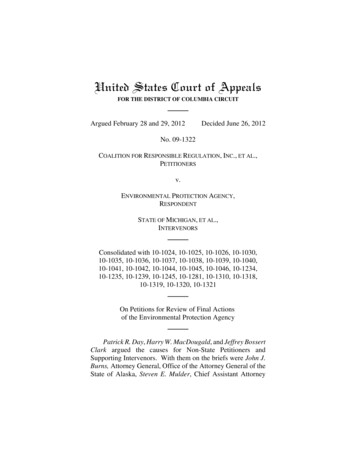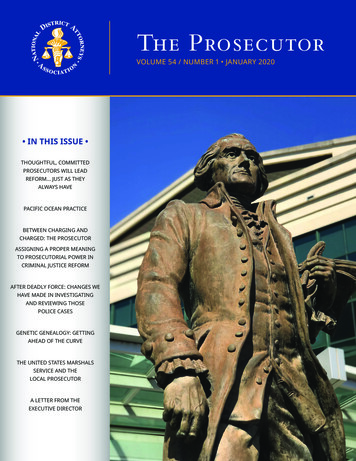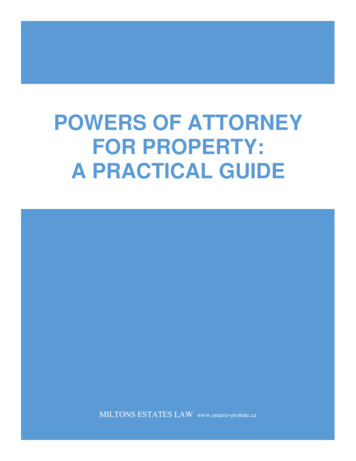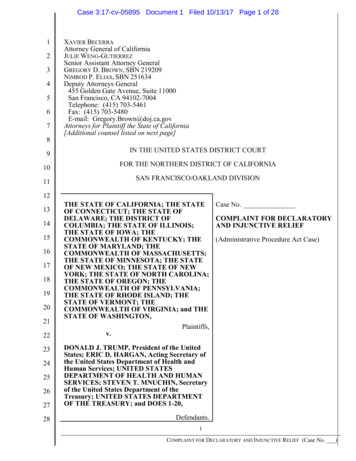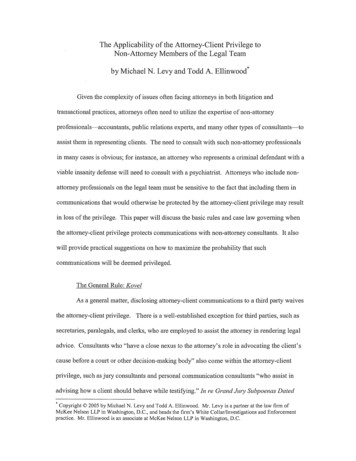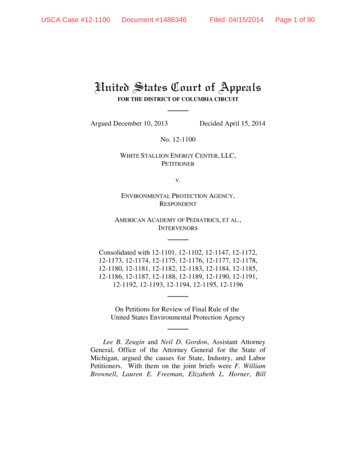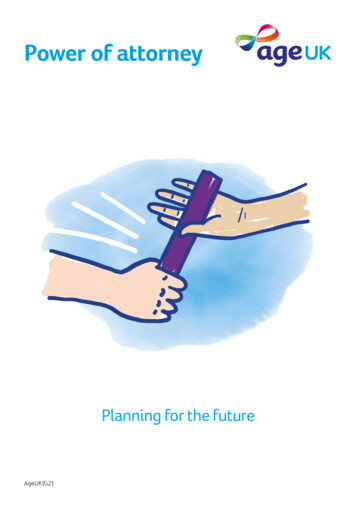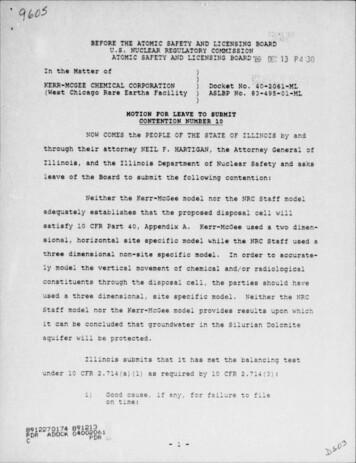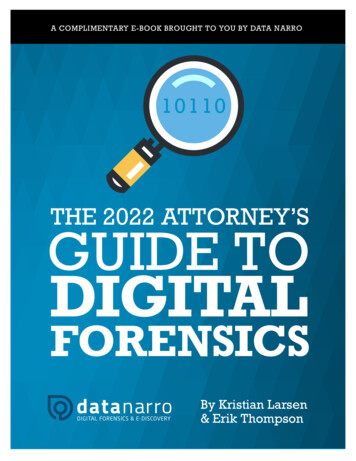
Transcription
A COMPLIMENTARY E-BOOK BROUGHT TO YOU BY DATA NARRO10110THE 2022 ATTORNEY’SGUIDE TODIGITALFORENSICSdatanarroDIGITAL FORENSICS & E-DISCOVERYBy Kristian Larsen& Erik Thompson
The 2022 Attorney’s Guide toDigital ForensicsINTRODUCTIONThe past decade has produced a seismic shift in the worldof civil litigation and evidentiary discovery. Whereas digitalevidence once played a supporting role, in 2022 it is likelythe star player. Smartphones, social media, messagingapps, and an abundance of connected devices are trackingour daily routines and generating mountains of data.This data, when properly collected and analyzed, can bean invaluable resource for attorneys that need evidenceto strengthen a case. As technology has advanced, thepotential sources of digital evidence have grown exponentially. By developing a solid understanding of the processes and capabilities of modern digital forensics, informedattorneys can generate a distinct advantage for theirclients and cases.PURPOSEThe purpose of this e-book is to provide attorneys and legal professionals with a contemporary field guide to modern digital forensics. While we’ll cover the basics of digitalforensics, our goal is to detail recent advances and provideinsight into what you can expect in the coming decade.While we may touch on elements of criminal investigations, we will focus on digital forensic applications for civillitigation. Along the way, we’ll alert you to new sourcesof digital evidence, providing you with the awareness tobetter drive e-discovery efforts for you and your 01001011001010011001010010100100010100100010 2022 by Data Narro, LLC. This e-book may not be copied or distributed without written permission. All rights reserved.
0110100101101010010011What Exactly is Digital Forensics?If we look at the standard definition, we might describe digital forensics as the detailedinvestigatory examination of digital media to uncover electronic evidence that supportsor refutes a hypothesis. As a branch of forensic science, digital forensics follows established processes and procedures that ensure that digital evidence collected during aninvestigation will maintain credibility and integrity for use in possible legal proceedings.More importantly, digital forensics tells the story of digital information. Skilled digital forensic investigators can trace the history of files and artifacts to help you build a stronglegal argument. How did a file get there? Who had control over that file? Where was ittransferred? Investigators can help prove that the defendant had knowledge of a document or that data was transferred to a third-party. Expert digital forensics helps wincases.Digital Forensics vs. E-DiscoveryThere is often a bit of confusion between the concepts of digital forensics and e-discovery. Are they the same thing? Are they different concepts altogether? The answer issomewhere in between.In general, we can say that e-discovery is an activity, typically engaged in civil litigation,that is used to identify and preserve potential digital evidence that resides in the form ofElectronically Stored Information (ESI). E-Discovery follows well-established processes that help maintain the integrity of ESI during evidence gathering, and later, throughpotential litigation.3 2022 by Data Narro, LLC. This e-book may not be copied or distributed without written permission. All rights reserved.
When digital forensics is engaged in as part of the e-discovery process, it is typicallythought of as a subset of that process.Digital ForensicsProcessELECTRONIC DISCOVERYREFERENCE oducePresentCollectAnalyzeFigure 1: The above EDRM diagram is a conceptual represention of an e-discovery project. This model breaks down the typicalphases of e-discovery. We have highlighted those phases that are most likely to include elements of digital forensics.To understand this relationship better, let’s refer to the popular Electronic DiscoveryReference Model (EDRM). In the diagram above, the various phases of an e-discoveryproject are broken down. Digital forensics occurs primarily in the collection and preservation stages, but can also contribute to the identification and processing stages.It is important to note that not all e-discovery projects will require digital forensics work.In some e-discovery cases, it is merely enough to request a set of email records from theopposing party. Their IT staff can pull the request information and forward it on. No deepinvestigative or forensic activities are necessary.However, discovery requests are rarely that simple. More often than not, parties willneed to provide information from a broad set of repositories that include not only email,but messaging, file transfer, website search activities, and more. Some of this information may be readily retrievable, but most of the time it is not. In cases such as these, adigital forensics investigation is recommended.DIGITAL FORENSICS OFTEN STANDS ALONEWe feel that it is important to mention that while digital forensics may be employedduring an e-discovery effort, digital forensics often exists independently from e-discovery. Digital forensics can be used anytime there is a need to recover data or establish theprovenance of digital information. Attorneys should employ digital forensics services tohelp determine the strength of potential litigation or gain insight into drafting a discovery request. Forensic experts can provide strong investigative and analytical resourcesthat can help make or break a case.The History of Digital ForensicsMany of you may be familiar with the term computer forensics. You may be wonderingwhy we now call this field digital forensics? The explanation has to do with the fact thatwe are living in an increasingly digital world.4 2022 by Data Narro, LLC. This e-book may not be copied or distributed without written permission. All rights reserved.
Computer forensics has its roots in the ‘60s and ‘70s, but back then, it was hardly a science. Examinations were performed by system administrators knocking around mainframe computers, operating without any methodology or scientific processes. Over time,national organizations and investigative agencies brought a level of scientific rigor to thisemerging field.While computer forensics may have been an appropriate term for a time, we are nowliving in an era of interconnected smart digital devices—phones, TVs, speakers, watches, doorbells, and cameras, each with the potential to track and store information aboutour activities. It’s only been about ten years since we saw a big push toward renamingthe field. It makes sense—it’s simply more appropriate to refer to this field as “digitalforensics” as this phrase encompasses a broader range of potential electronic devicesand digital yzeReportThe 5 Stages of Digital ForensicsBefore we get too far along, let’s review the five primary stages of a digital forensics investigation. While different organizations may categorize the stages differently, all examinations willinclude these necessary steps in one form or another.ASSESSMENTWhenever civil disputes turn litigious, we always encourageattorneys to bring a digital forensics professional aboard theirteam. Before any data is ever collected, a digital forensics professional will need to assess the situation and develop a gameplan for a forensic investigation.5 2022 by Data Narro, LLC. This e-book may not be copied or distributed without written permission. All rights reserved.100110
Ideally, you will have the services of a digital forensicsprofessional before your meet and confer conference.These pre-trial meetings can have a dramatic effecton the case and its outcome, so it’s important thatyou have the best possible resource for understandingcomplex IT infrastructure, data storage, file formats,and production strategies. Guidance from a digital forensics professional can help guide you to the data thatis most critical to your case. You’ll end up with a planthat enables you get the information you need whilelowering the overall cost of collection.Even if you contract a digital forensics professionallater in the game, he or she will need to have a strongunderstanding of the pending litigation and the typesof information that could be useful in supporting or refuting the central claims of the case. If there is alreadya discovery request in place, the investigator will needto see it. It is critical that the investigator defines whatthey are looking for and how they intend to collect thedata in a manner that is consistent with the FederalRules of Civil Procedure (FRCP).WHAT IS AFORENSIC COPY?The term forensic copy typically refersto an exact bit-for-bit copy of the entirephysical hard drive, including unallocatedand slack space.However, it is possible to make a forensiccopy of drive volumes (like the c: drive),cloud storage accounts, or individualfolders.In these cases, we might be better servedif we modify our definition of a ‘forensiccopy’ to be an accurate replica of thesource data in which the metadata andcontent are not altered.A forensic copy is almost always createdas a read-only container with self-authentication built into it.To better understand forensic copies andthe technology that enables them, checkout this helpful article:CLICK TO VISIT ARTICLELet’s suppose that you are asked to investigate a casewhere an employee is suspected of stealing intellectualproperty from an employer. It may be obvious to search the accused’s computer harddrive, but it is essential to identify other potential sources of information—this mayinclude thumb drives, email, messaging apps, social media accounts, mobile phones,or cloud-based storage. A good digital forensics professional will be able to assess theeffort required to examine a broad assortment of digital repositories and can devise aplan to obtain that information. Additionally, the investigator can guide efforts to draft adiscovery request or respond to one.100101COLLECTIONAs a generalrule, it is unacceptable to perform digital examina10010100101001tion directlyonsource media that contains potentially discover1101010010100100101100101001able information.Even experienced IT personnel can damage theintegrity of10010100101001an investigation by making informal backups or doing00010100101001a cursory examinationof the source media. A quick peek at a tar00101100101001get’s emails may trigger events that can delete materials, updatemetadata,10010100101001or overwrite information located in unallocated space.00010100100010Before any examination can occur, the source media needs to becopied in a way that preserves the integrity of the original. This can be accomplished bymaking a forensic copy, which is usually the first step a forensics investigator will take.A forensic copy will be a 100% faithful replica of the original media and will include alldata visible through the file system,as well as data hidden in unallocated space. As this10010100101001duplicate is created, it is run throughan algorithm that calculates a hash value, a type 10010100100101100101001 2022 by Data Narro, LLC. This e-book may not be copied or distributed without written permission. All rights reserved.1001010010100100010100100010100101
digital fingerprint that can be used10010100101001to assure that the forensic copy remains accurate to11010100101001the source.0010110010100110010100101001A recent amendment to US Federal Rule of Evidence 902 establishes that preserved00010100101001electronic data should be self-authenticating,which is exactly what creating a forensic00101100101001copy achieves. The rule provides thatproperly certified electronic data will carry with it a10010100101001strong presumption of authenticity.Becausethe forensic copy is verified to be identical00010100100010100101to the original and it is protected against future alteration, it is generally considered tobe a more reliable source of truth than the original media, which can be 01Now that wehave a forensic copy to work from, we can begin11010100101001the examination.The goal of this stage is to extract relevant data00101100101001from the digitalhaystack of information, preparing for in-depthanalysis in10010100101001the next stage. Using their skill, experience, and spe00010100101001cialized tools,the forensic examiner will perform many differentactions to00101100101001gather the data they are looking for.1001010010100100010100100010In this phase, you can expect your investigator to: recover deleted informationparse containers such as mailboxes, computerbackups, phone backups, and compressed archivesretrieve artifacts such as web browser history andweb searchesidentify the history of opened files and connectedstorage devicesaccurately identify file typescull unnecessary files such as duplicate and system/application filesExaminers also know that different operating systemsand applications leave digital artifacts in a variety ofhidden places. While a document may appear to bedeleted to the ordinary user, examiners know to checkspecific directories or system files for duplicates anddrafts that can be recovered. They understand thatthey can examine system resources such as restorepoints and registry files to find hidden data. For filesthat don’t appear in the active file system, examinerscan use a technique called “file carving” to search theunallocated sectors of a hard drive. By searching forspecific key signatures, the forensics examiner cantarget specific file types for recovery.DENISTINGIf you hang around digital forensics longenough, you’ll encounter the cryptic termdeNISTing.During a typical hard drive search, an investigator will uncover a broad assortmentof files present on the computer. Manytimes, the pool of potentially discoverablematerial will include standard system orapplications files, even though these fileswill have no relevance to an investigation.DeNISTing is a technique to efficientlyremove these files.NIST is the acronym for National Instituteof Standards and Technology, a government agency that maintains a projectcalled the National Software ReferenceLibrary. This library contains the hashvalues of thousands of traceable computer programs and operating systems.The process of deNISTing removes knownapplication files from the pool of potentially discoverable data.Learn more about deNISTing below.CLICK TO VISIT ARTICLE7 2022 by Data Narro, LLC. This e-book may not be copied or distributed without written permission. All rights reserved.
1001000010001011001000010By this stage, the examiner will have a pretty good understanding of the type of datathey are looking for, often driven by the professional profile of the computer’s primaryuser. An engineer might store engineering files; a financial advisor may have accountingor banking files. With an encyclopedic understanding of specialized applications and filetypes, the digital forensics examiner will tailor their search to find the most relevant100101information.Before the gathered data is analyzed, it is crucial to reduce the volume of informationby intelligently culling files that have no relevance to the investigation. In the process ofdeduping, duplicate versions of files are removed from the collection. Another processthat can be used to cull data is informally called deNISTing. (See sidebar.)ANALYSISWith our data set parsed and consolidated, we are ready todo a deep dive. During this phase, a digital forensics examinerperforms an in-depth analysis of the evidence that has beengathered, attempting to interpret the data, draw insights, andultimately tell a story.The investigator will use powerful tools to find specific typesof data using searches based on keywords, file types, anddate ranges, while analyzing a file’s content, metadata, datestamps, and more. The examiner will pull the gathered evidence together, correlatingtimelines, identifying the provenance of key evidence, and providing expert analysisusing all available information.Most people believe that the goal of a forensic investigation is to uncover an electronic “smoking gun,” and sometimes that is the case. But more often it is the meticulousanalysis of available information that builds a narrative around a discovered piece ofevidence that helps win cases.REPORTINGIn the final phase of a digital forensics investigation, the digitalforensics professional can prepare a report that documents all relevant findings of the investigation. The expert report will describethe activities undertaken during the investigation, providing atimeline that correlates evidence with user activities, supplemented with expert opinions and conclusions.Once a report is submitted, investigators will often verbally walka client through the findings. Reports can sometimes be misinterpreted when taken out of context, so it is important to have the investigator explain theresults and be available to answer questions.0101810010100101001Sometimes a final report is not desired—once submitted, a report can become discov11010100101001erable as evidence by the opposing party. Forensics professionals can forgo a formal00101100101001report and discuss their findings with the client attorneys in order to guide their subse10010100101001quent examination 00010100100010 2022 by Data Narro, LLC. This e-book may not be copied or distributed without written permission. All rights reserved.1001011010001011001000010001011001000010
Depending on the needs of the case and the agreement between the parties, digitalevidence can be provided in several different ways. In some cases, it is preferable toproduce files in their native format. In other cases, it is not. For instance, let’s supposewe have a batch of original email files in the .eml format. By themselves, they are notentirely human readable without proper parsing. However, they can be quickly turnedinto human-readable PDF files during the reporting process.Should it be necessary, investigators are usually available to provide expert testimony incourt. They can attest to their findings and demonstrate proper chain of custody for allevidence produced.Six Hot Digital Forensics TrendsThe field of digital forensics has changed immensely over the last decade. During this time,we’ve seen the rise of smartphones and tablets along with many other interconnected digitaldevices. Let’s take a look at some of the most important trends that will shape digital forensics.SMART PHONESFormer FBI director James Comey once stated, “The cellphone is probably the single most important piece of evidence you will find at a crime scene today.” Even for those of100101us working on civil matters, smartphonescan yield a wealthof 010010100100010100100010Smartphones have become our indispensable digital companions, traveling nearly everywhere with us. Increasingly,smartphones are the preferred platform that provides us10010100101001access to email, social media, messaging, and the World Wide Web.Using geolocation11010100101001information, smartphones can provide us with driving directions or track our 10001010010100110010100101001Because of this, smartphones are critical in most digital forensic investigations. There0010110010100111010100101001are now a host of powerful tools that allow forensic investigators10010100101001to capture a wide00101100101001range of information from modern mobilephones. Information andactivities can often1001010001010010001010010100101001be correlated to specific time periods and geographic locations. Becausesmartphones00010100101001often make automated backups to computers or cloud storage, datais often preserved00101100101001longer than most users are aware.1001010010100100010100100010EPHEMERAL APPSAlong with the rise of smartphones, we have seen the emergence of a category of mobiles apps that promise to delivermessages that are temporary in nature. Snapchat pioneered100101this market, buoyed by a user base of teenagers looking toprotect their communications from the prying eyes of parents.Snapchat allows users to share information that is 101001000101001000109 2022 by Data Narro, LLC. This e-book may not be copied or distributed without written permission. All rights reserved.
100100010100100010ically deleted just seconds after it is viewed, minimizing the chancethat embarrassingdigital content will come back to haunt the user.Although Snapchat built its base by providing users with a sense of security and freedom, flaws in the system have emerged. Besides the obvious issues of users photographing incoming messages, it has come to light that deleted Snapchat content may10010100101001be recoverable by using some fairly basic forensic techniques. (Link: Read more about11010100101001recovering SnapChat data.)0010110010100110010110010100101001Recently, a woman and boyfriend were charged with murder after00010100101001they conspired to killthe woman’s husband to claim life insurance money. What is notableabout the case is00101100101001that the couple plotted the crime over Snapchat which they believedwouldmake it dif10010100101001ficult for police to trace. As the case unfolds, it will be interesting tolearn about the role00010100100010that digital forensics plays. (Link: Keep up with the Data Narro blog to follow this case.)INTERNET OF THINGS (I o T)We are now living in an era of IoT–the Internet of Things. Inessence, IoT refers to the ecosystem of digital devices thatconnect to the Internet. Devices that were previously built toperform simple mechanical tasks now have circuits, memory,and sensors that can detect our presence and record information about our lives. Doorbells, speakers, thermostats,watches, TVs, and even toothbrushes have all become “smart,”routinely tracking our activities and recording informationin the form of metrics, logs, or audio/visual files. In the pastdecade, the amount of discoverable information generated bythe devices in our homes has exploded. Most of us are leaving an invisible trail of digitalevidence all around us as we go about our lives.There is a trade-off that we are making on a daily basis. By embracing modern technology, each of us is implicitly agreeing to give up anonymity in many of our regular activities.While most people believe there is little harm in the digital traces we leave behind, mostpeople don’t understand the extent that those digital traces are being captured.Widely reported in 2018 was the news that a judge in New Hampshire ordered therelease of recordings from an Amazon Echo device located in a home where two womenwere murdered. To those in the digital forensics and e-discovery fields, it’s a reminder ofjust how intertwined our everyday lives have become with a vast assortment of Internet-enabled digital devices.Our advice? Attorneys should take a more comprehensive view of potential evidencethat could be found on current and emerging IoT devices. These devices can hold usefulinformation about a user’s location or actions that can be used to strengthen a legalcase.10 2022 by Data Narro, LLC. This e-book may not be copied or distributed without written permission. All rights reserved.
SSD sAs technology progresses, so do the components in a typicalcomputer. Whereas traditional hard drives were the standard,in 2019 it is likely that a modern computer will come equippedwith newer solid-state drives (SSDs). Solid-state drives aresilicon-chip based and nearly identical to the technology foundin flash memory cards. SSDs offers the advantage of a reducedfootprint, lightning-fast response times, and lower powerconsumption. From a forensics point of view, SSDs can be a bitmore challenging.Traditional hard drives rely on rotating magnetic platters in which bits of data are readand written by physically repositioning a read/write head. When a file is deleted, it isoften left in place, with only the indexpointer to the data being removed. That file will10010100101001remain in place until it is overwrittenwhenspace is needed.1101010010100100101100101001100101SSDs,on the other hand, require a10010100101001clean slate to write files. Before new data can bewritten, write-ready blocks will be00010100101001created by clearing the data from the needed space.If this data clearing happens soon00101100101001after a file is marked deleted, this effectively preventsinvestigators from recovering data10010100101001sitting in unallocated space. Let’s use this analogy:00010100100010writing to a hard drive is like painting—newdata can simply be painted over the old, anSSD operates more like a chalkboard—old data must be erased before new data can bewritten.ENCRYPTIONAs computer software and hardware manufacturers take1001010010100110010100101001consumer privacy concerns seriously,they have started to offer1101010010100111010100101001painless ways to automatically encryptthe information that we0010110010100100101100101001100101store 100101or transmit. Whereas encryptionused to be a technique1001010010100110010100101001only employed by the tech-savvy,00010100101001everydayconsumers can now00010100101001apply encryption easily. Let’s look00101100101001atafewwaysthat encryption00101100101001can be 10100100010Full-Drive Encryption: Full-drive encryption (FDE) is precisely what it sounds like, a method of encoding an entire drive, effectively obscuring all of its data. It is a relatively simple matter to examine the contents of an unprotected hard drive. But if the drive is encoded with FDE, viewing any files withouta decryption key is nearly impossible–the entire drive and its data structure will be10010100101001completely obfuscated.1101010010100100101100101001In the past, FDE required specialized software and a fair amount of patience. Now10010110010100101001adays, both Apple and Microsoft offer simple methods for consumers to employ00010100101001FDE. Windows operating systemscome with an easy-to-use utility called BitLock00101100101001er; on a Mac, you’ll use FileVault.Oncea drive is encrypted, an investigator’s ability10010100101001to examine data from a drive00010100100010without a password is severely hampered or, morelikely, entirely prevented.11 2022 by Data Narro, LLC. This e-book may not be copied or distributed without written permission. All rights reserved.
Encrypted Messaging Apps: More and more messaging apps have found a wayto differentiate themselves by including end-to-end encryption into their communication offerings. We’ve seen that while some ephemeral apps have built flawedsystems (SnapChat), others have made products fortified with nearly impenetrablesecurity.One such product is Signal which offers end-to-end encryption for text, video, andvoice messaging. This means that even if messages are intercepted during transmission or storage, the captured data is unintelligible. Signal’s parent company itself cannot decode the messages or turn them over to authorities, even if subpoenaed. Other secured messaging apps include Silence, Cyphr, and Telegram. EvenFacebook’s nearly-ubiquitous Messenger app has a “secret conversation” featurethat offers end-to-end encryption.File/Folder Encryption: There are many products on the market (7-Zip, AxCrypt)that allow you to encrypt individual files or folders. These products can preventunauthorized users from seeing the contents of a protected file. Many times, youdon’t even need a separate encryption utility. Users of Word, Excel, or Acrobat haveoptions to password-protect their files right from the application menu.10010100101001Even if information is encrypted, forensicsexaminers have techniques to help recover11010100101001information. Let’s suppose a user created, and then encrypted, an Excel spreadsheet. It00101100101001is helpfulto understand that Excel creates periodic backups of active documents in the10010110010100101001event of an application crash. While00010100101001these copies are automatically deleted, they couldbe recoverable from unallocated spaceusing file carving techniques.0010110010100110010100101001While it may be nearly impossible tocrack the file encryption, it may be easier to focus00010100100010energy on determining the password protecting the information. In civil litigation, gainingaccess to encrypted media may simply require negotiations between opposing parties.TAR/AI/MACHINE LEARNING:The latest hot topic in the world of digital forensics and e-discovery is technology-assisted review 10010100101001or TAR. While this technology11010100101001fits better into the realm of e-discovery,it is well worth a mention00101100101001here. TARis a software-based approach that aids the document10010110010100101001review phase of an e-discovery effort.TAR leverages the power00010100101001of machine learning to identify and tag potentially responsive00101100101001materials, significantly reducing the amount of time and effort10010100101001spent in the most resource-intensivephase of e-discovery.00010100100010In earlier iterations of the technology, users were required to tag a set of “seed data”that TAR algorithms could use to analyze and learn from. Current versions of the technology allow users to simply begin tagging responsi
A COMPLIMENTARY E-BOOK BROUGHT TO YOU BY DATA NARRO GUIDE TO DIGITAL FORENSICS THE 2022 ATTORNEY'S 10110. The 2022 Attorney's Guide to Digital Forensics . Digital forensics can be used anytime there is a need to recover data or establish the provenance of digital information. Attorneys should employ digital forensics services to


